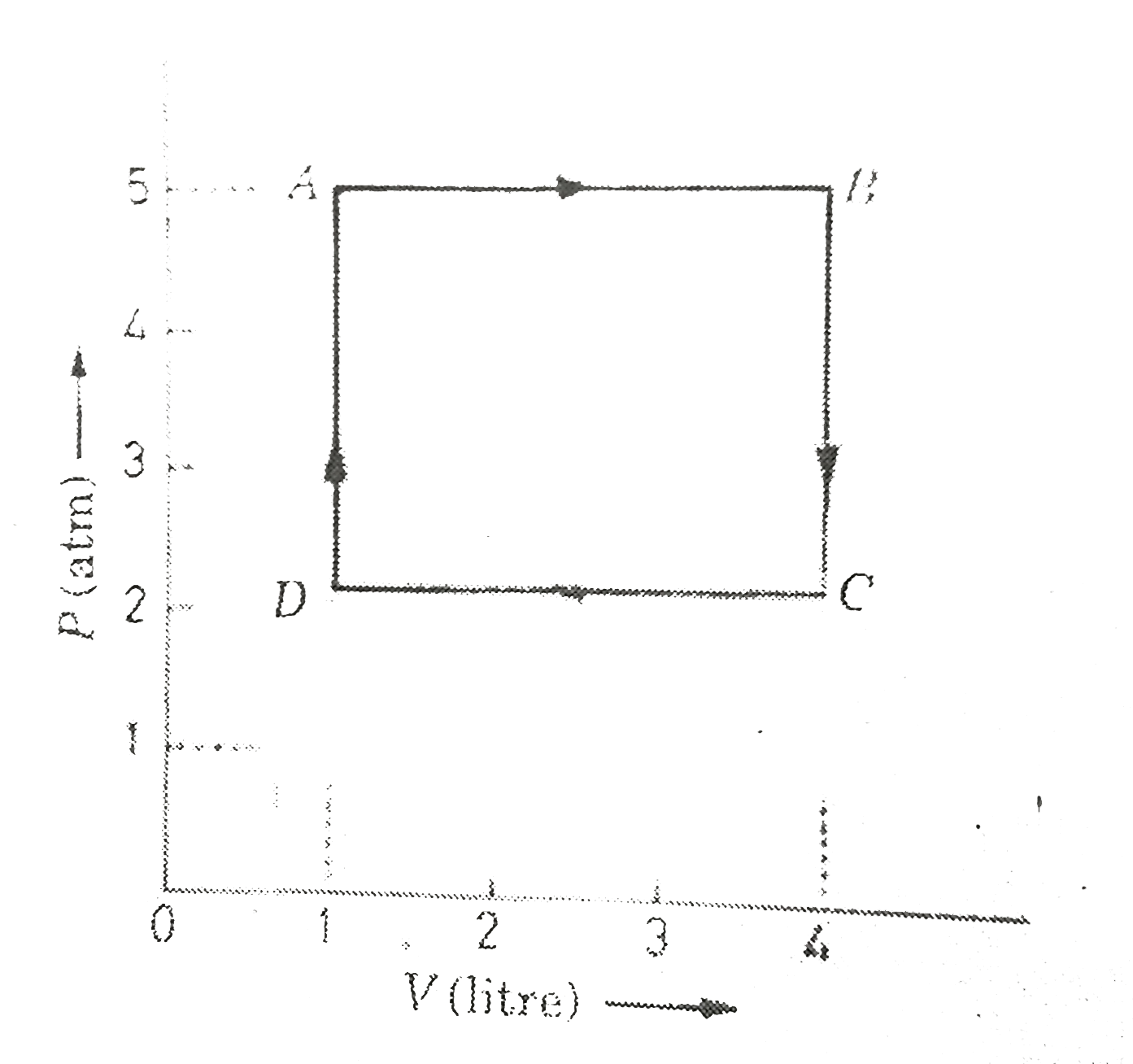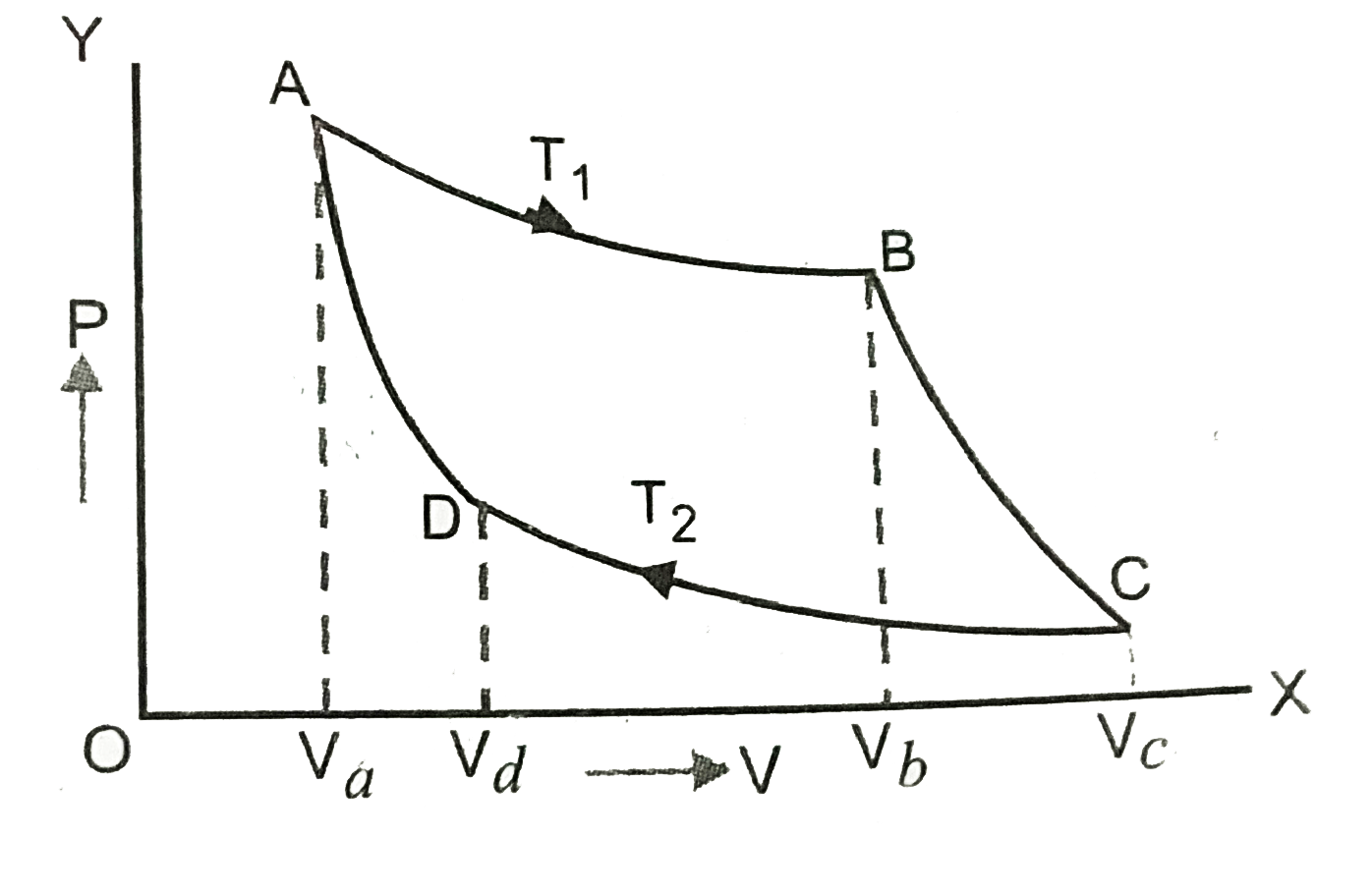Problems from competitive examinations from DHANPAT RAI & CO PHYSICS (HINGLISH) THERMODYNAMICS for Class 11
| Class 11 | PHYSICS |
| Chapter | THERMODYNAMICS |
| DHANPAT RAI & CO PHYSICS (HINGLISH) | Problems from competitive examinations |
| Medium | English |
| Academic Year | 2023-2024 |
Question 2
The P−V diagram for a cyclic process is a triangle ABC drawn in order (figure). The co-ordinates of A,B,C are (4,1),(2,4)and(2,1) respectively. The co-ordinates are in the order (P,V) Pressure is in Nm−2 and volume is in liter. Calculate work done during the process from A to B, B to C and C to A. Also, calculate work done in the complete cycle.View SolutionQuestion 5
1.0m3 of water is converted into 1671m3 of steam at atmospheric pressure and 100∘C temperature. The latent heat of vaporisation of water is 2.3×106Jkg−1. If 2.0 kg of water be converted into steam at atmospheric pressure and 100∘C temperature, then how much will be the increases in its internal energy? Density of water 1.0×103kgm−3, atmospheric pressure =1.01×105Nm−2.View SolutionQuestion 9
A cyclinder with a movable piston contains 3mols of hydrogen at standard temperature and pressure. The walls of the cyclinder are made of a heat insulator, and the piston is insulated by having a pile of sand on it. By what factor does the pressure of the gas increases, if the gas is compressed to half its original volume? Given γ=1.4.View SolutionQuestion 10
The compression ratio of a certain diesel engine is 15. this means that air the cylinder is compressed to 1/15 of its initial volume. If the initial pressure is 1.0×105 Pa and the initial temperature is 300 K, find the final pressure and temperature after compression. air is mostly a mixture of oxygen and nitrogen and γ=1.4View SolutionQuestion 24
One mole of a perfect gas, initally at a pressure and temperature of 105N/m2 and 300 K, respectively, expands isothermally unitl its volume is doubled and then adiabatically until its volume is again doubled. Find final pressure and temperature of the gas Find the total work done during the isothermal and adiabatic processes. Given γ=1.4. Also draw the P-V diagram for the process.
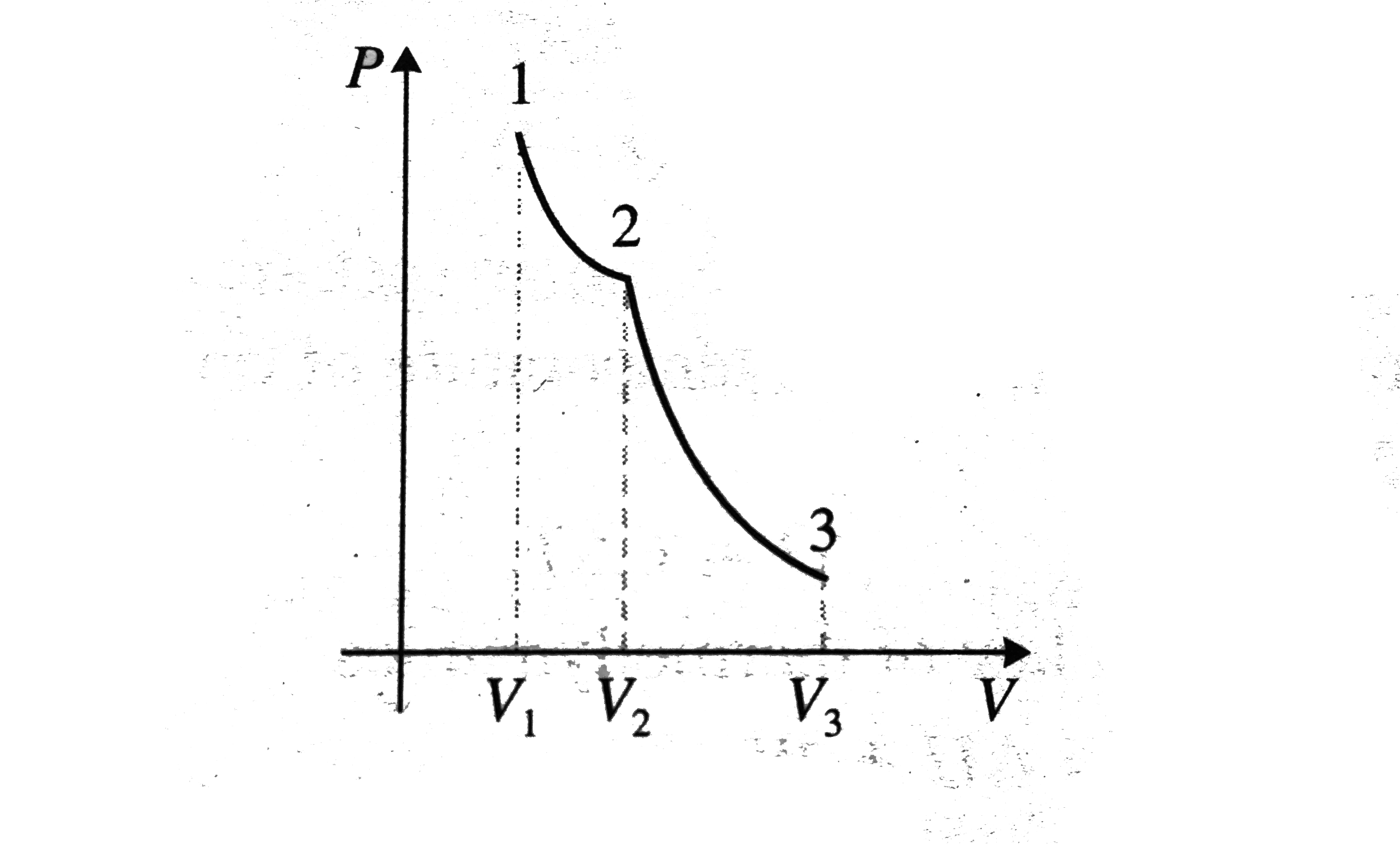 View Solution
View SolutionQuestion 34
An ideal engine operates by taking in steam from a boiler at 327∘C and rejecting heat to a sink at 27∘C. The engine runs at 500r± and heat taken is 600kcal in each revolution. Calculate(i) efficiency of engine (ii) work done in each cycle (iii) heat rejected in each revolution and (iv) power output of engine.View SolutionQuestion 35
During isothermal expansion at 800 K, the working substance of a Carnot's engine extracts 480 cal of heat. If the sink be at 300 K, calculate (i) the work done by the working substance during isothermal expansion (ii) the work done on the substance during isothermal compression (iii) the efficiency of the ideal engine.View SolutionQuestion 38
Two carnot engines A and B are operates in series. The first one A receives heat at 800 K and rejects to a reservoir at temperature TK. The second engine B revives the heat rejected to a heat reservoir at 300 K. calculate the temperature TK for the following cases.
(i) When the outputs of the two engines are equal.
(ii) When the efficiencies of the two engines are equal.View SolutionQuestion 49
A carnot engine having a perfect gas aas the working substance is driven backwards and is used for freezing water already at 0∘C. If the engine is driven by 500W electric motor with an efficiency of 60% how long will it take to freeze 15kg of water? The working temps of the engine are 15∘C and 0∘C. The system involves no energy losses. Given latent heat of ice =333×103Jkg−1.View SolutionQuestion 50
Heat is flowing through a rod of length 25.0cm having cross-sectional area 8.80cm2. The coefficient of thermal conductivity for the material of the rod is K=9.2×10−2kcals−1m−1.∘C−1. The Temperatures of the ends of the rod are 125∘C and 0∘C in the steady state. Calculate (i) temeprature gradient in the rod (ii) temperature of a point at a distance of 10.0cm from the hot end and (iii) rate of flow of heat.View SolutionQuestion 52
A brass boiler has a base area of 0.15m2 and thickness 1.0 cm it boils water at the rate of 6.0kg/min, When placed on a gas. Estimate the temperature of the part of the flame in contact with the boiler. Thermal conductivity of brass=109J/s−.∘C ) and heat of vapourization of water =2256J/g.View SolutionQuestion 54
A metal rod of length 20 cm and diamter 2 cm is convered with a non conducting substance. One of its ends is maintained at 100∘C , while the other end is put at 0∘C. It is found that 25 g ice melts in 5 min. calculate the coefficient of thermal conductivity of the metal. Latent that of ice = 80calg−1.View SolutionQuestion 57
Two vessels A and B of different materials but having identical shape, size and wall-thickness are filled with ice and kep at the same plane. Ice melts at the rate of 100g−1min and 150g−1min in A and B respectively. Assuming that heat enters the vessels through the walls only, calculate the ratio of thermal conductivity of their materials.View SolutionQuestion 58
Two plates of equal areas are placed in contact wih each other. Their thickness are 2.0 cm and 5.0 cm respectively. The temperature of the external surface of the first plate is −20∘C and that of the external surface of the second plate is 20∘C. What will be the temperature of the current surface if the plates (i) are of the same material, (ii) have thermal conductivities in the ratio 2:5.View SolutionQuestion 59
Three bars of equal lenghts and equal area of cross-section are connected in series. Their thermal conductivities are in the ratio of 2:4:3. If the open ends of the first and the last bars are at temperature 200∘C and 180∘C respectivity in the steady state, calculate the temperature of both the junctions.View SolutionQuestion 60
Heat is supplied to a slab of cork, 5cm thick and of 2m2 by a heating coil spread over its surface. When the current in the coil is 1.18 A and the potential difference across its end is 20 V, the steady temperatures of the faces of the slab are 12.5∘C and 0∘C. Assuming that the whole of the heat developed in the coil is conducted through the slab, calculate the thermal conductivity of the cork.View SolutionQuestion 61
What is the temperature of the steel-copper junction in the steady state system show in Fig. 7(e).17? Length of steel rod = 15.0 cm, length of the copper rod = 10.0 cm, temperature of the furnace =300∘C, temperature of other end 0∘C. The are of cross-section of the steel rod is twice that of the copper rod. (Thermal conductivity of steel =50.2js−1m−1K−1 and of copper =3895js−1m−1K−1).
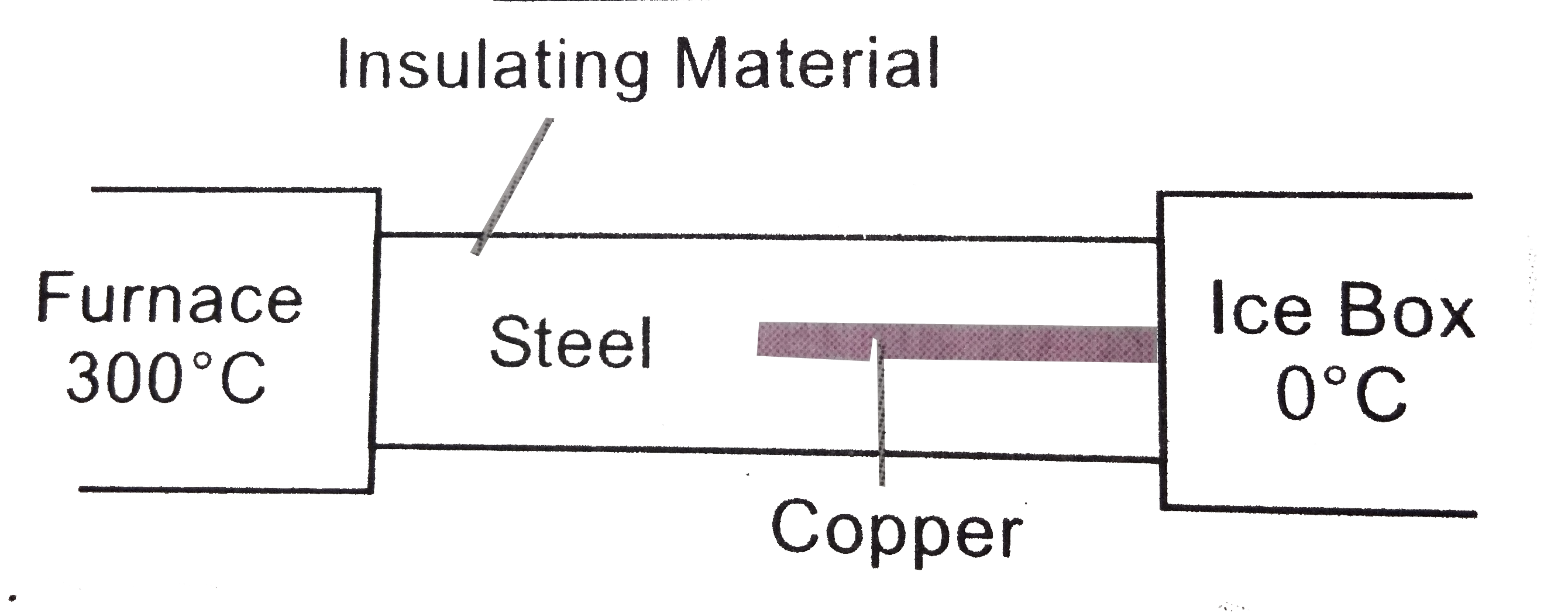 View Solution
View SolutionQuestion 80
An ideal gas is taken through a cyclic thermodynamic process through four steps. The amounts of heat involved in these steps are Q1=5960J,Q2=−5585J,Q3=−2980JandQ4=3645J, respectively. The corresponding quantities of work involved are W1=2200J,W2=−825J,W3=−1100JandW4 respectively.
(1) Find the value of W4.
(2) What is the efficiency of the cycle View SolutionQuestion 81
A vertical hollow cylinder contains an ideal gas. The gas is enclosed by a 5kg movable piston with an area of cross-section 5×10−3m2. Now, the gas is heated slowly from 300K to 350K and the piston rises by 0.1m. The piston is now clamped at this position and the gas is cooled back to 300K. Find the difference between the heat energy added during heating process and energy lost during the cooling process. (1atm pressure=105Nm−2] View SolutionQuestion 83
Two moles of an ideal monoatomic gas are confined within a cylinder by a massless and frictionless spring loaded piston of cross-sectional area 4×10−3m2. The spring is, initially in its relaxed state. Now the gas is heated by an electric heater, placed inside the cylinder, for some time. During this time, the gas expands and does 50J of work in moving the piston through a distance 0.10m. The temperature of the gas increases by 50K. Calculate the spring constant and the heat supplied by the heater. Patm=1×105N/m2R=8.314J/mol−KView SolutionQuestion 85
An ideal gas with pressure P, volume V and temperature T is expanded isothermally to a volume 2V and a final pressure Pi, If the same gas is expanded adiabatically to a volume 2V, the final pressure Pa. The ratio of the specific heats of the gas is 1.67. The ratio PaP1 is .......View SolutionQuestion 86
An ideal gas having initial pressure P, volume V and temperature T is allowed to expands adiabatically until its volume becomes 5.66V while its temperature falls to T/2.
(i) How many degrees of freedom do the gas molecules have?
Obtain the work done by the gas during the expansion as a function of the initial pressure P and volume V.View SolutionQuestion 88
The rectangular box shown in Fig has partition which can slide without friction along the length of the box. Initially each of the two chambers of the box has one mole of a mono-atomic ideal gas (λ=5/3) at a pressure P0, volume V0 and temperature T0. The chamber on the left is slowly heated by an electric heater. The walls of the box and the lead wires of the heater is negligible. The gas in the left chamber expands pushing the partition until the final pressure in both chambers becomes 243P0/32. Determine (i) the final temperature of the gas in each chamber and (ii) the work done by the gas in the right chamber.
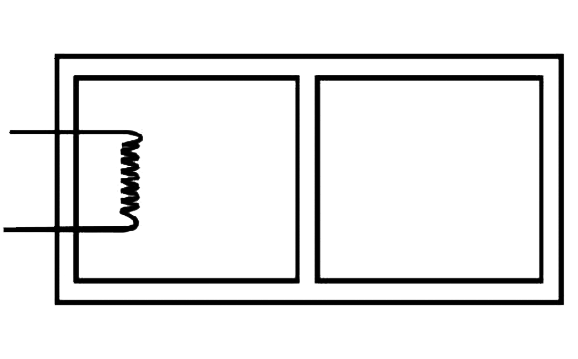 View Solution
View SolutionQuestion 90
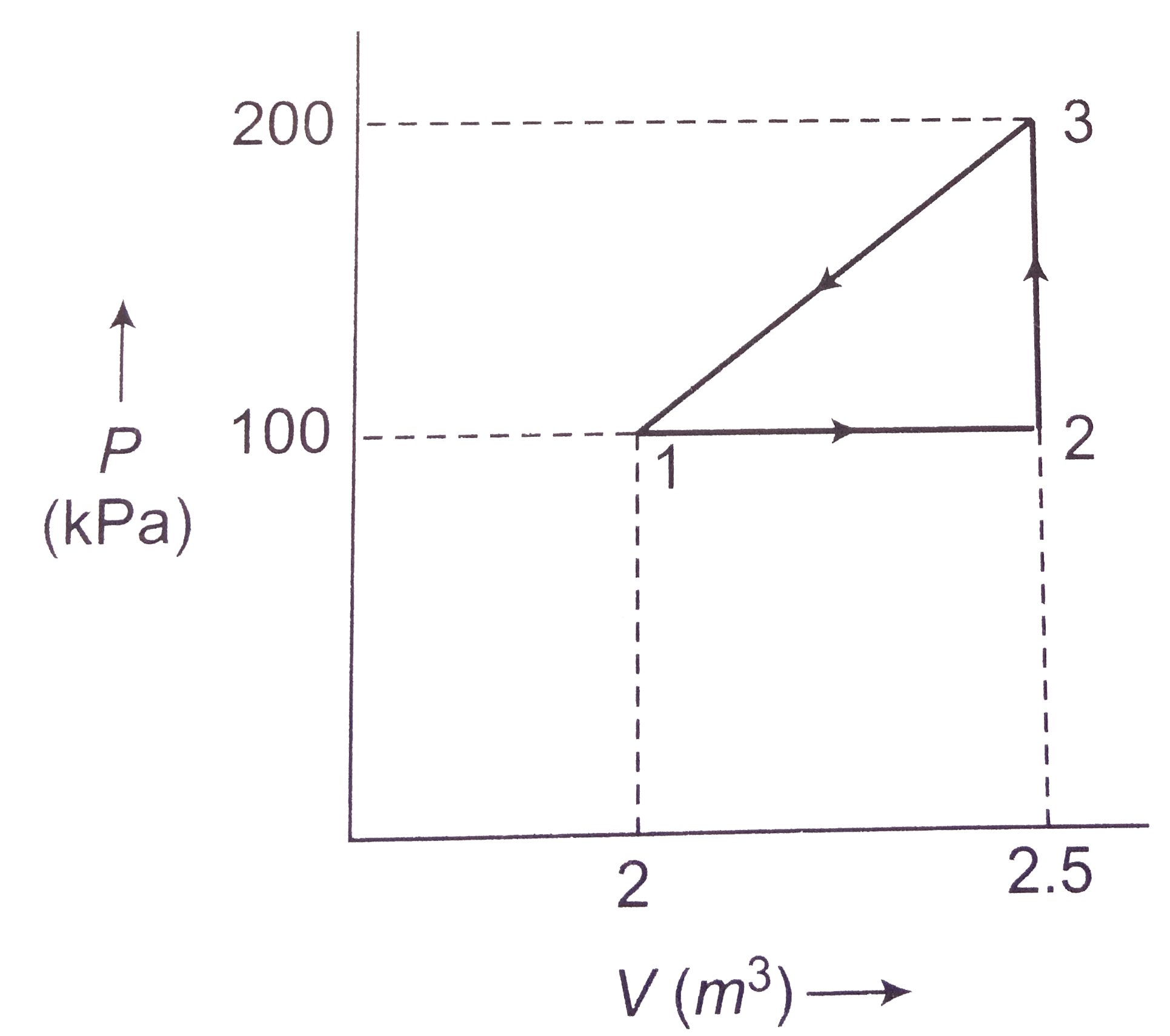
In the figure an ideal gas changes is state from state A to state C by two paths ABC and AC.
(a) Find the path along which the work done is least.
(b) The internal energy of the gas at A is 10 J and the amount of heat supplied to change its state to C through the path AC is 200 J. Calculate the internal energy at C.
(c) The internal energy of the gas at state B is 20 J. Fid the amount of the heat supplied to gas to go from A to B.View SolutionQuestion 91
A sample of 2kg of monoatomic helium (assumed ideal) is taken through the process ABC and another sample of 2kg of the same gas is taken through the process ACD as shown in (figure). Given molecular mass of He =4andR=8.3Jmole−1K−1
(i) What is the temperature of He in each of the states A, B, C and D?
(ii) How much is the heat involves in process , ABC and ADC?
 View Solution
View SolutionQuestion 92
One mole of a diatomic ideal gas (γ=1.4) is taken through a cyclic process starting from point A. The process A→B is an adiabatic compression, B→C is isobaric expansion, C→D is an adiabatic expansion, and D→A is isochoric. The volume ratios are VA/VB=16andVC/VB=2 and the temperature at A is TA=300K. Calculate the temperature of the gas at the points B and D and find the efficiency of the cycle. View SolutionQuestion 93
One mole of an ideal monatomic gas is taken round the cyclic process ABCA as shown in figure. Calculate
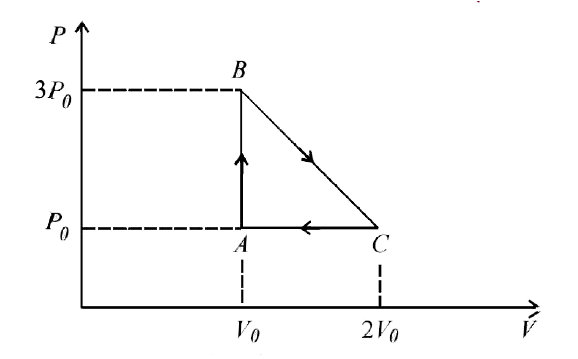
(a) the work done by the gas.
(b) the heat rejected by the gas in the path CA and the heat absorbed by the gas in the path AB,
(c) the net heat absorbed by the gas in the path BC,
(d) the maximum temperature attained by the gas during the cycle. View SolutionQuestion 94
Two moles of an ideal monoatomic gas, initially at pressure p1 and volume V1, undergo an adiabatic compression until its volume is V2. Then the gas is given heat Q at constant volume V2.
(i) Sketch the complete process on a p-V diagram.
(b) Find the total work done by the gas, the total change in its internal energy and the final temperature of the gas. [Give your answer in terms of p1,V1,V2,QandR]View SolutionQuestion 95
Two metal cubes A and B of same size are arranged as shown in Figure. The extreme ends of the combination are maintained at the indicated temperatures. The arrangement is thermally insulated. The coefficients of thermal conductivity of A and B are 300W/m∘Cand200W/m∘C, respectively. After steady state is reached the temperature t of the interface will be ......
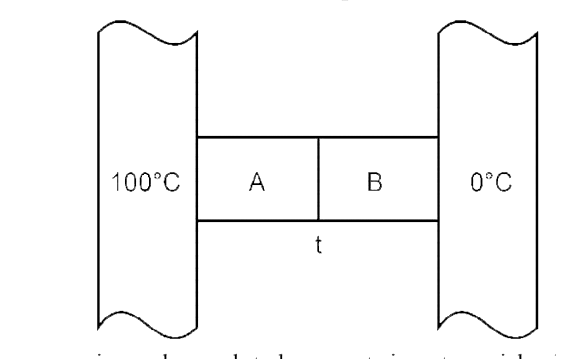 View Solution
View SolutionQuestion 96
One end of a copper rod of uniform cross-section and of length 3.1 m is kept in contact with ice and the other end with water at 100°C . At what point along it's length should a temperature of 200°C be maintained so that in steady state, the mass of ice melting be equal to that of the steam produced in the same interval of time. Assume that the whole system is insulated from the surroundings. Latent heat of fusion of ice and vaporisation of water are 80 cal/gm and 540 cal/gm respectively
 View Solution
View SolutionQuestion 97
A cylinder of radius R made of a material of thermal conductivity K1 is surrounded by cylindrical shell of inner radius R and outer radius 2R made of a material of thermal con-ductivity K2 The two ends of the combined system are maintained at two differnet tem-peratures There is no loss of heat across the cylindrical surface and system is in steady state What is the effective thermal conductivity of the system
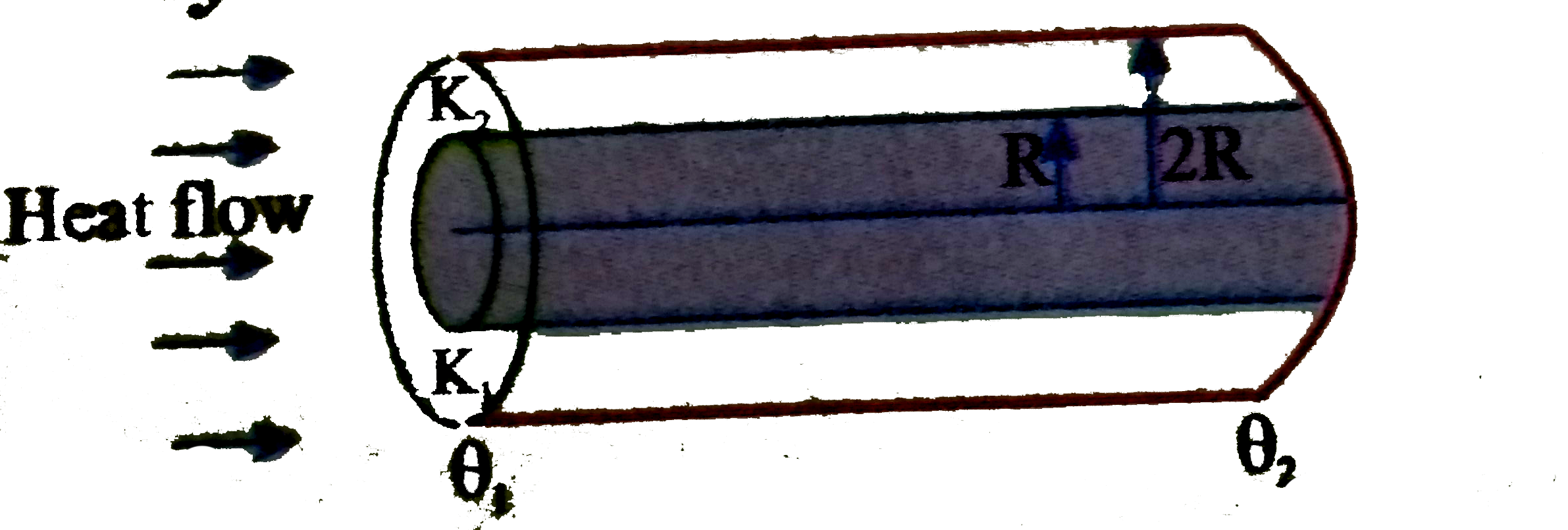 .View Solution
.View SolutionQuestion 98
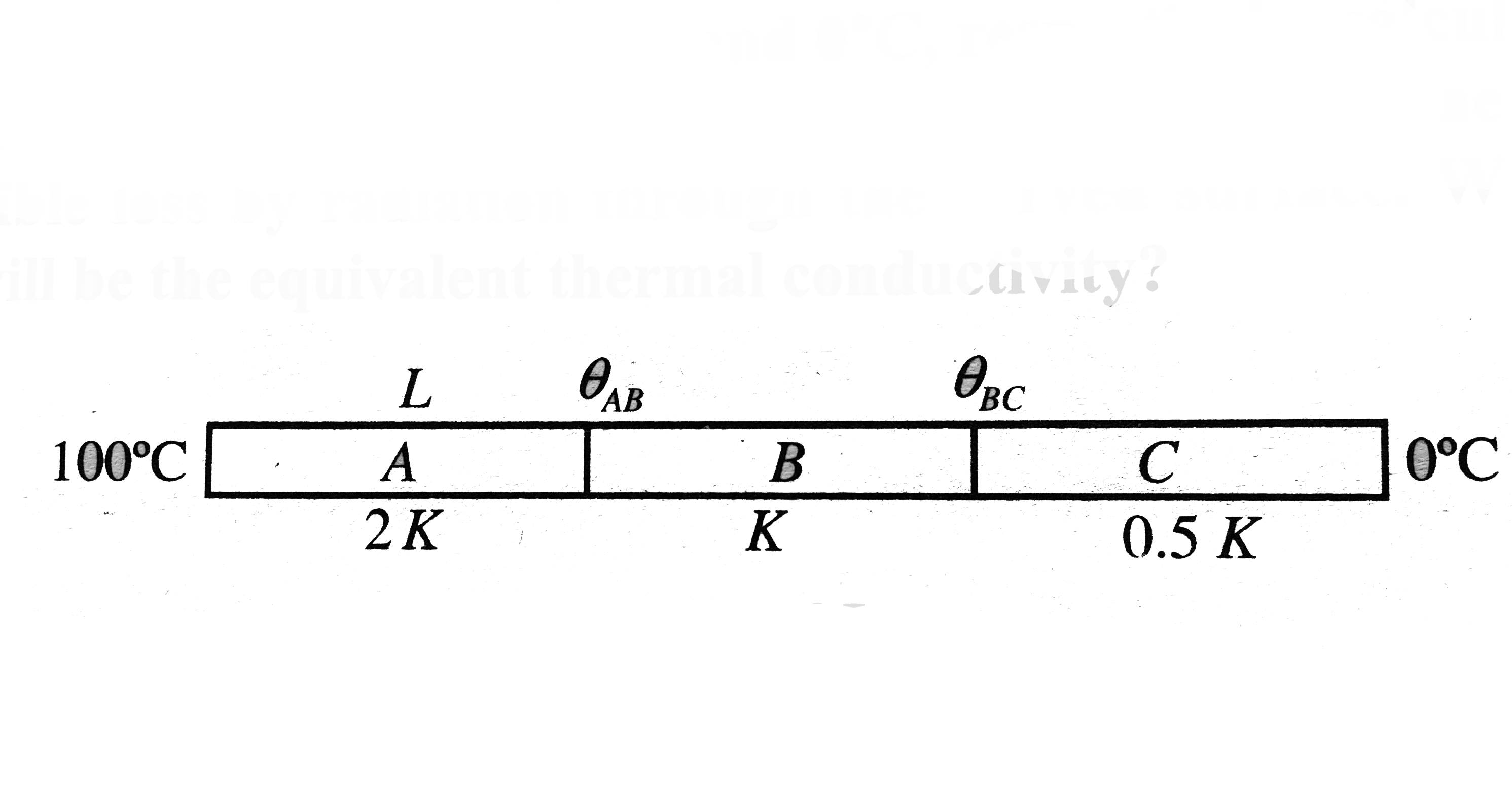
Three cylindrical rods A, B and C of equal lengths and equal diameters are joined in series as shown if Fig. Their thermal conductivities are 2K, K and 0.5K, respectively. In steady state, if the free ends of rods A and C are at 100∘C and 0∘C, respectively, calculate the temperature at the two junction points. Assume negligible loss by radiaiotn through the curved surface. What will be the equivalent thermal conductivity?View SolutionQuestion 99
An electric heater is used in a room of total wall area 137m2 to maintain a temperature of +20∘C inside it when the outside temperature is −10∘C. The walls have three different layers materials . The innermost layer is of wood of thickness 2.5 cm, in the middle layer is od cement of thickness 1.0 cm and the outermost layer is of brick of thickness 25.0 cm. find the power of the electric heater. Assume that there is no heat loss through the floor and the ceiling. The thermal conductives of wood, cement and brick are 0.125,1.5and1.0wa/m/.∘C respectively.View SolutionQuestion 100
A cylindrical block of length 0.4 m and area of cross-section 0.04m2 is placed coaxially on a thin metal disc of mass 0.4 kg and of the same cross - section. The upper face of the cylinder is maintained at a constant temperature of 400 K and the initial temperature of the disc is 300K. if the thermal conductivity of the material of the cylinder is 10watt/m.K and the specific heat of the material of the disc is 600J/kg.K, how long will it take for the temperature of the disc to increase to 350 K? Assume for purpose of calculation the thermal conductivity of the disc to be very high and the system to be thermally insulated except for the upper face of the cylinder. View SolutionQuestion 101
A wire of length 1 m and radius 10−3m is carrying a heavy current and is assumed to radiate as a black body. At equilibrium, its temperature is 900 K while that of surrounding is 300 K. The resistivity of the material of the wire at 300 K is π∘×10−8 ohm m and its temperature coefficient of resistance is 7.8×10−3/C (stefan's constantσ=5.68×10−8W/m2K2.
The current in the wire is nearlyView Solution
